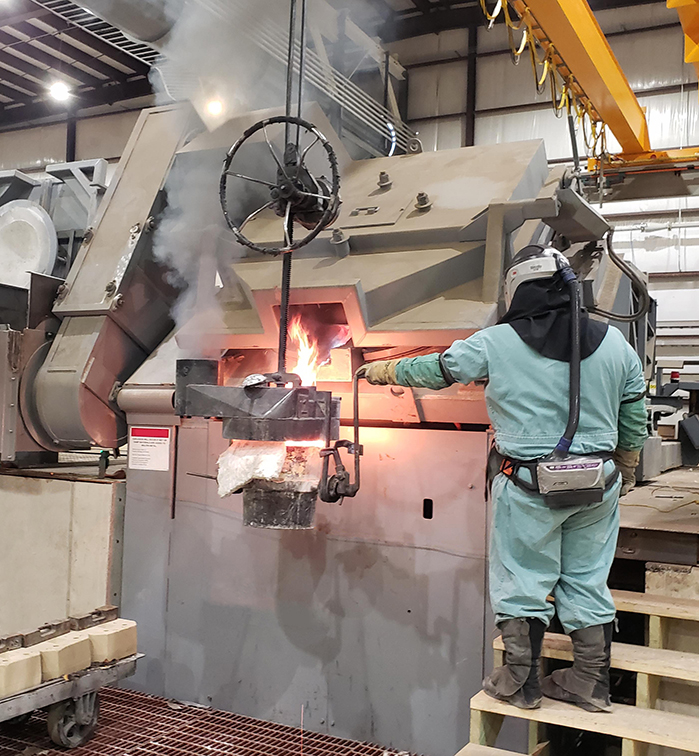Lead-Free, Silicon-Based Brass Changes the Game for Pipe Replacement
Date:
Publication:
Publication:
Changing standards have allowed for critical product improvements in lead-free, silicon-based brass.. This innovation is stronger and more sustainable for utilities replacing aging infrastructure.
US water utilities and local governments need to find ways to bridge the gap between their current capital spending and projected need for capital spending based on the age and life expectancy of their water infrastructure. With more than 16% of North America’s underground water infrastructure exceeding its designed service life, it’s no surprise that there are more than 240,000 water main breaks a year, with a 27% increase in break rates since 2012. The problem is continuing to worsen, with up to 30% nonrevenue water in some utilities and a growing number of states requiring water loss audits.
Moving forward, water utilities will have to use multiple approaches to extend the life of their assets, including measured allocation of capital funds, product innovation, predictive maintenance planning, and rate increases. Manufacturers are investing millions in research and development to improve product design and manufacturing processes using new materials that will help utilities address aging infrastructure. One of these areas is in underground service line valves and fittings for drinking water systems.
ANSI/AWWA STANDARD C800 ANSI/AWWA Standard C800, Underground Service Line Valves and Fittings, was built around the use of one brass alloy, C83600, also known as leaded red brass. During the past two decades, the water sector has transitioned to brass alloys that meet the lead-free definition for most surfaces contacting potable water. The transition was possible for a broad range of waterworks products because there are many lead-free (as defined by the Safe Drinking Water Act) brass options available to the market; however, only three lead-free alloys were available for C800 products, and all three were bismuth-based brass.
In 2018, the US Department of the Interior identified bismuth as one of 35 critical minerals. Critical is defined as (1) a nonfuel mineral essential to the economic and national security of the United States, (2) the supply chain of which is vulnerable to disruption, and (3) serves an essential function in manufacturing products that would have significant consequences if absent. Although recognizing a mineral as critical doesn’t disqualify an alloy from use, the details surrounding the inclusion of the mineral on the “critical” list and the extent to which it affects sourcing should be considered in a larger evaluation strategy. AWWA recently revised its C800 standard to include three lead-free, silicon-based brass options. Given the potential for supply-chain concerns with bismuth and the availability of proven lead-free alternatives, some manufacturers are transitioning from bismuth-based brass to silicon-based brass.
Silicon-based Brass Enters the Field

Research and innovation drive competition in a healthy industry, and competition leads to improved designs and higher-quality products for the end user. It also provides better price stability through mitigation of supply-chain risks. Design engineers have been searching for new and improved ways to address the changing standards and regulations by creating better products while focusing on the most pressing issue for utilities, namely, aging infrastructure. When it comes to materials, some are better at standing the test of time as well as the tough and varying conditions of underground water distribution systems. Accordingly, the most cost-effective solution is having a long-lasting, tough product. In the case of C87850 silicon-based brass, this alloy is a competitive alternative to C89833 bismuth-based brass and C83600 leaded red brass, with exceptional mechanical strength and structural integrity.
Other waterworks products, such as fire hydrants and gate valves, have used lead-free silicon-based brass for decades and have already met performance criteria in product standards set by AWWA, Underwriters Laboratories (UL), and FM Approvals. The C87850 alloy also consistently exhibits zero dezincification under the ISO 6509 test, which has a pass criteria of up to 200 μm. Mueller conducted detailed tests and investigations and discovered C87850 silicon-based brass consistently exhibits zero dezincification when exposed to a corrosive bath for 144 hours under UL requirements, which is far and above the 24 hours specified under the International Organization for Standardization (ISO) Standard 6509 (Corrosion of Metals and Alloys— Determination of Dezincification Resistance of Copper Alloys With Zinc— Part 1: Test Method) parameters.
A Sustainable Pipe Selection
Manufacturing new products today also requires adherence to higher standards of environmental sustainability that can add to the initial cost, but these higher standards are better for workers and the environment, and they minimize use of natural resources. Silicon is the second-most abundant element in Earth’s crust, whereas bismuth, a byproduct of lead mining, is only about twice as abundant as gold. In terms of manufacturing, the lower melting temperature of some silicon-based brass alloys reduces energy consumption and carbon dioxide emissions during both initial melt and while maintaining the charge in a molten state. The lower melting temperature reduces other hazardous fume emissions as well as generation of silica and flue dust.
Silicon-based brass service line valves and fittings are a product evolution that water utilities can now use when replacing aging infrastructure. These products have a long life expectancy and help the industry meet environmental and sustainability goals. With more manufacturers investing in research and development activities to accelerate product development, utilities will have better tools to repair and replace infrastructure. Using better materials that are more easily sourced will also help to address the supply-chain issues that have affected more than just the water industry.
Author Larry Aulich, Mueller Senior Product Manager, Mueller Water Products